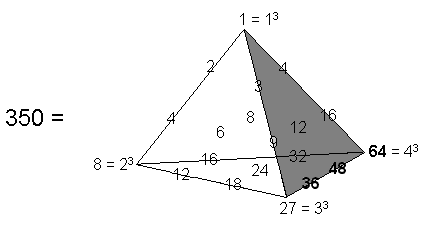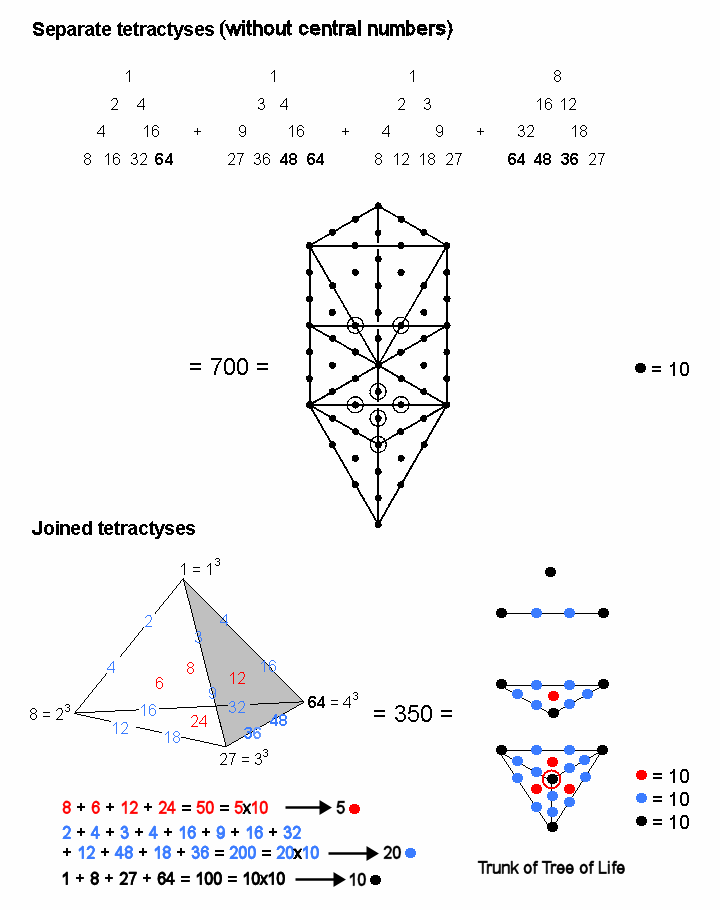
Figure 3. The Tetrahedral Lambda.
| << Previous 1... 2 3 [4] 5 6 ...16 Next >> |
The Tetrahedral Lambda & its correspondence with the trunk of the Tree of Life
The two sloped lines of Plato’s Lambda consist of six integers 2, 4 (=22), 8 (=23), 3, 9 (=32) & 27 (=33) below the integer 1 at its apex. But this pattern of integers is incomplete, actually being part of a tetractys array of ten integers. For the Pythagoreans, the perfect number 10 represented the unfolded completeness of Divine unity or wholeness symbolised by the tetractys, whose rows of points denoted the integers 1, 2, 3 and 4. It is therefore natural to add to Plato’s Lambda, whose sequences of integers 1, 2, 4, 8 and 1, 3, 9, 27 result from multiplying 1 by, respectively, 2 and 3, the sequence 1, 4, 16, 64, which is generated by successive multiplications of the same starting number 1 by 4. Combining this sequence with the two others generates two new tetractyses:
|
1 |
1 |
|||||||
| 2 | 4 | 3 | 4 | |||||
|
4 |
8 |
16 |
9 |
12 |
16 |
|||
| 8 | 16 | 32 | 64 | 27 | 36 | 48 | 64 |
The three tetractyses can be regarded as forming three faces of a tetrahedron with the number 1 at a vertex, the face opposite it being formed by their bases:
|
8 |
|||
| 12 | 16 | ||
|
18 |
24 |
32 |
|
| 27 | 36 | 48 | 64 . |
As successive integers on the left-leaning side of this fourth tetractys are twice the previous one, the missing, central integer not shared with the other tetractyses = 2×12 = 24 =1×2×3×4. The Pythagorean generalisation of Plato's Lambda creates a tetrahedral array of 20 integers (Fig. 3):
|
|
Figure 3. The Tetrahedral Lambda. |
Their sum is 350. This number is the sum of the four integers 1 = 13, 8 = 23, 27 = 33 and 64 = 43 at the apices of the tetrahedron:
13 + 23 + 33 + 43 = 100,
and the 16 (=42) integers that sum to 250 and which are located at positions of hexagonal yods corresponding to Sephiroth of Construction. The sum of the four integers 6, 8, 12 and 24 at the centres of the tetractyses (these correspond to Malkuth) is 50, which is the number value of the Godname ELOHIM assigned to Binah. This means that the sum of the 12 integers on the six edges of the tetrahedron that are not located at vertices = 250 – 50 = 200. Therefore, the sum of all 16 integers on its boundary = 100 + 200 = 300. Notice that the proportions of these sums for integers on the edges of the tetrahedron are 100:200:300 = 1:2:3.
The 20 integers are arranged in four layers containing 1, 3, 6 & 10 integers. The sum of the ten integers in the highest three layers of the tetrahedron shown in Figure 3 is 65, which is the number value of ADONAI, the Godname of Malkuth. The three of these integers that are at the centres of tetractyses add up to 26, which is the number value of YAHWEH, the Godname of Chokmah, whilst the sum of all four integers at centres of tetractyses is 50, which is the number value of the Godname of Binah, the next Sephirah after Chokmah. The sum of the 10 integers in the Lambda Tetractys (first face of the Tetrahedral Lambda) is 90. This is the 65th composite number (composite numbers are integers that have divisors, i.e., they are not prime numbers).
As 351 (the number value of Ashim, the Order of Angels assigned to Malkuth — see Table 1), is the sum:
351 = 1 + 2 + 3 + ... + 26,
where 26 is the number value of YAHWEH, the number 350 is the sum of the first 25 integers after 1:
2 + 3 + 4 +.... + 26 = 350.
This property relates the number of YAHWEH to the dimension 248 of the rank-8 Lie group E8 as the number of spin-1 gauge bosons predicted by E8×E8 heterotic superstring theory to transmit the forces between this type of superstring of ordinary matter (the second, similar group E8 describes the symmetry of the forces between superstrings of invisible "shadow matter"):
248 = (22 + 32 + 42 + ... + 262)/25.
For any positive integer n, n2 is the sum of the first n odd integers:
n2 = 1 + 3 + 5 + ... + 2n–1.
Therefore, there are 350 odd integers making up these 25 squares whose arithmetic mean is the number 248 that is very important to superstring theory. This illustrates the archetypal character of the number 350 as the sum of the 20 integers that compose the Tetrahedral Lambda.
The number 350 is prescribed by ELOHIM in the following way: as
35 = 62 – 1 = 3 + 5 + 7 + 9 + 11,
i.e., 35 is the sum of the first five odd integers after 1, 350 (=35×10) is the sum of (5×10=50) odd integers, where 50 is the number value of ELOHIM.
|
|
|
Figure 4. The trunk of the Tree of Life is made up of 26 geometrical elements and 35 yods. |
The 10 Sephiroth of the Tree of Life are located at a point (Kether), the ends of the path joining Chokmah & Binah, the corners of a triangle (Chesed-Geburah (Tiphareth) and the corners of a tetrahedron (Netzach-Hod-Yesod-Malkuth). This geometrical sequence is called the "trunk" of the Tree of Life (Fig. 4). YAHWEH prescribes its 26 geometrical elements (see diagram). Constructed from tetractyses, it has 35 yods. As the Tree of Life has 70 yods, its other parts (called its "branches") also have 35 yods. If the Decad (10) is assigned to each yod, the trunk embodies the number 350. The 10 Sephirothic points embody the number 100, which is the sum of the integers at the vertices of the Tetrahedral Lambda. The former mark out the Tree in the same way that the vertices do for the tetrahedral array of 20 integers. The 25 other yods in the trunk generate the number 250, which is the sum of the 16 remaining integers. They include the red hexagonal yods shown in Figure 5 below at the centres of the five tetractyses making up the trunk of the Tree of Life. They generate the number 50, which is the sum of the red numbers at the centres of the faces of the Tetrahedral Lambda. The following correspondences exist:
50 → 5 red hexagonal yods at centres of tetractyses sum to 50;
100 → 10 black Sephirothic points sum to 100;
200 → 20 blue hexagonal yods on sides of tetractyses sum to 200.
Notice that corresponding yods in the Tetrahedral Lambda and trunk are of the same type. These correspondences demonstrate that the Tetrahedral Lambda is arithmetically analogous to the trunk of the Tree of Life.
 |
Figure 5. Correspondence
between the Tetrahedral |
The 40 integers in the four separate tetractyses sum to 750. This is 15×50, where 15 is the number of YAH, one of the two Godnames assigned to Chokmah, and 50 is the number of ELOHIM. Figure 5 indicates that the 36 integers on the sides of the tetractyses prescribed by the Godname ELOHA of the Sephirah Geburah with number value 36 sum to 700 — the same as the number generated by assigning the number 10 to the 70 yods of the Tree of Life with its 16 triangles turned into tetractyses. In this sense, the boundaries of the four separate tetractyses are the arithmetic counterpart of the complete Tree of Life, whilst the corresponding edges of the tetrahedron whose 16 integers sum to 300 are the counterpart of the 30 yods with 10 assigned to them that delineate the geometrical outline of the trunk of the Tree of Life (this formally includes the yod symbolising the mathematical starting point of the trunk, namely, the point located at Kether). The Godname ELOHIM with number value 50 prescribes the number 70 (and, therefore, 700) because 70 is the 50th composite number. The sum of the 16 integers at the corners and centres of the four separate tetractyses is 350 — the same as the sum of the 20 integers in the tetrahedron whose faces the tetractyses form.
The section The seven musical scales (see in particular pages 5-13) explains how the fourth face of the Tetrahedral Lambda generates the tone ratios of the notes of the Pythagorean musical scale in a symmetric way that is missing from the historical manner whereby they were often calculated, which was based upon the pattern of numbers in its first face.
| << Previous 1... 2 3 [4] 5 6 ...16 Next >> |